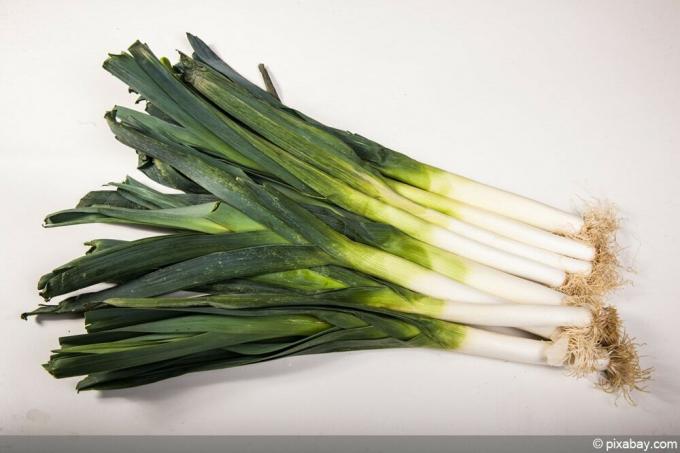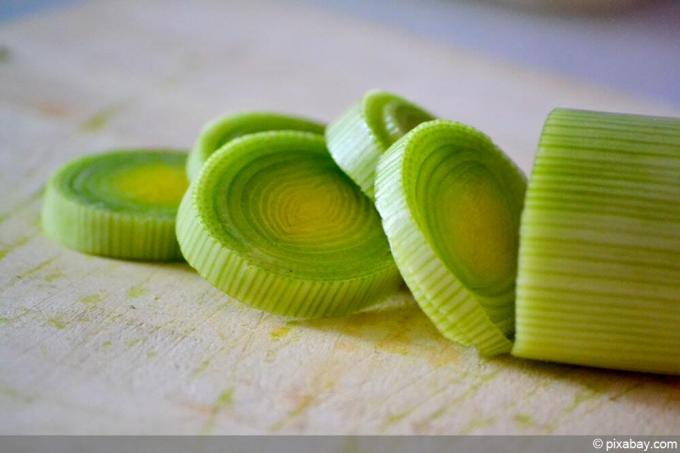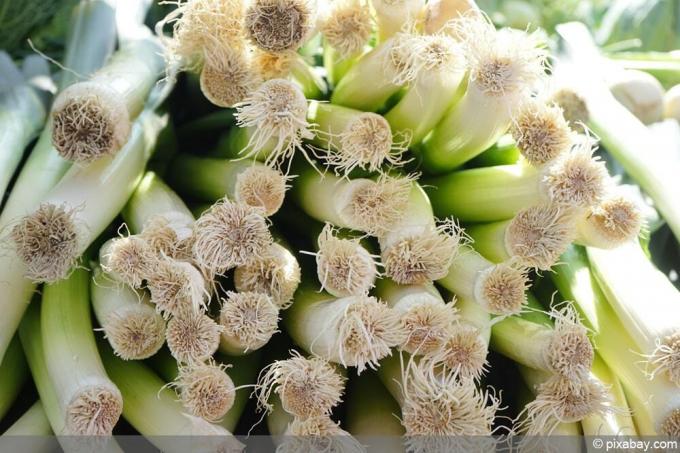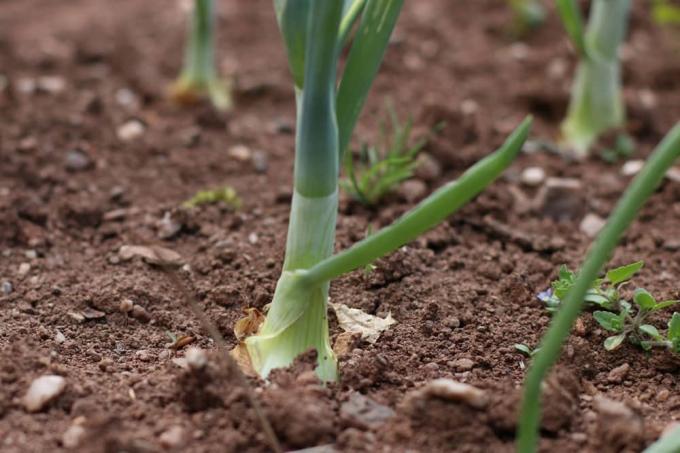

Table of contents
- Sowing or young plants
- sowing
- Prefer
- planting
- location and soil
- Neighbors
- Care
- Fertilize
- Pour
- harvest
- multiply
- sorts
- summer leek
- autumn leek
- winter leek
- diseases and pests
- Conclusion
Depending on the time of planting and harvesting, there are summer leeks, autumn leeks and winter leeks. But all leek varieties (Allium porrum) are amaryllis plants that do not form bulbs. At least not in their cultivated form as garden leeks. This cultivar of field garlic is herbaceous, biennial and can grow up to 80 centimeters long. Even the ancient Egyptians are said to have had green leeks on their menu. Before deciding on an extension, it doesn't hurt to know how much maintenance is required.
Sowing or young plants
That is the question that every hobby gardener will ask himself first: Do I grow it Grow leeks from seed yourself or do I buy pre-grown young plants when the time comes? There is no question that it takes less effort to start planting the young, thin leek plants in mid-March.
sowing
Anyone who has opted for the more complex variant of sowing is faced with two further decisions:
- prefer the seeds or sow directly
- Desired harvest time (summer leeks are brought forward from January)
In any case, it is advisable to give preference to leeks. By pre-growing in small peat pots, you can save yourself the pricking out. In addition, purely because of the time, it is imperative to bring the summer leek forward in January or February. Early plants are more resistant to diseases and pests in later stages.
Prefer

Small seed pots or earth press pots are perfect for growing. The latter can later simply be planted in the bed without damaging the fine roots.
- Seeds germinate faster if soaked in valerian broth overnight
- growing pots approx. five inches in diameter
- Potting soil or a mixture of peat and sand
- Press one or two seeds into the soil about a centimeter deep at a time
- pour on
- optimum temperature at least 14°C and bright
- germination time approx. 14 days
- are the seedlings approx. five centimeters tall, they can go into the bed
Tip:
If you want to harvest in August, you must prefer your leeks in January or February, sowing in the beginning of June is sufficient for the winter leeks.
planting
It doesn't matter whether they are young plants from the weekly market or leek plants you have grown yourself, from mid-May they can be planted outdoors, either in planting holes or planting trenches.
- Distance between the individual plants 15 to 30 centimeters
- Row spacing 40 to 60 centimeters
- either in approx. Make grooves 15 centimeters deep
- or in individual planting holes
- halfway deep into the holes, insert grooves
- Plantlets must be absolutely vertical
- pour well, muddy, for optimal stability
- no soil should fall into the leaf axils
For planting in planting holes, the soil in the bed should be well loosened. Holes are then pressed into the earth with a dibber. The pre-grown plants can be placed in the holes either with the peat pot or with all the soil from a seed pot. For the cultivation of leeks in ditches, the soil in the bed should also be loosened up well. The excavation can remain between the rows of plants. This makes it easy to pile up the leeks later.
location and soil

The leek likes it best in a sunny to semi-shady and still moist place. When it comes to temperatures, leeks are pretty tough. But the more sheltered it is from wind and cold, the fewer protective measures you have to take later on with winter leeks. Covering with fleece or brushwood can protect the winter leek from early, hard frosts.
While onions are among the medium eaters, leeks tend to be heavy eaters. So leeks need generous amounts of fertilizer. This means that the soil should be deeply loosened and mixed with organic fertilizer or mature compost before outdoor cultivation. Another option is to generously mix the soil with nettle manure or grass clippings. Coarse clods of earth should be broken up. Ideally, this preparation of the soil should already be carried out in January or February.
Tip:
If you want to prepare the soil in autumn: Pre-sowing with mustard or lupine is an ideal green manure for the leeks next spring.
Neighbors
As an intermediate culture, as long as the leeks have not yet picked up speed, salads are ideal. Good neighbors are:
- celery
- Kohlrabi
- Cucumber
- cabbage
- marjoram
- endive
- cabbage
- carrots
French beans, runner beans, beetroot and peas tend not to be good neighbors for the leek. If you add wormwood, oregano, carrots or radishes to the leek, you will also drive away the leek moth. Marigolds (marigolds) repel whitefly. Conversely, leeks placed between the strawberries can prevent mold on the strawberries.
Care
In addition to fertilizing and regular watering, the rows should be raked, loosened and weeded from time to time. Towards the end of the season, you can push the soil out of the furrows between the rows and onto the leeks. It is best to keep them below the leaf axils to keep the rings fairly clean from the ground.
Fertilize

As a heavy feeder, you can give the leeks a good start right from the start if you generously mix the soil with compost beforehand. If green manure has been pre-sowed, you can fold it in and still work in compost. After a month you then start with regular fertilizer applications, every two weeks. Either you water with nettle liquid manure or spread organic fertilizer on the soil. The fertilizer can be nitrogen-stressed.
Pour
In the main growth period, the leek needs a lot of water, especially in dry weather periods it has to be watered daily. Otherwise you have to find the right size. The leek must never dry out completely and permanent wetness or even waterlogging should be avoided.
harvest
Leeks need a relatively long ripening time, only five to six months after planting. The rods then have a diameter of about three centimeters. The summer and autumn leeks can be harvested gradually, but should be harvested before the first frosts. Winter leek is reasonably hardy and can be harvested throughout the winter on frost-free days. The harvest times of the leek varieties:
- Summer leek July, August
- Autumn leeks September – December
- Winter leek December – May
If the rods are simply cut off above the root and the ambient temperatures are still warm enough, new, somewhat thinner rods can form again. Otherwise, to harvest the whole stems, carefully use a rake to reach under the roots and lever them out of the ground a little. The best time to do this is early in the morning. Then the rods should rest for a while, so they lose some nitrite. In the afternoon you can pull them completely out of the ground.
multiply
If you want to use your own leeks as a basis for renewed cultivation, you have two options. One can wait until some stems that have not been harvested have blossomed in spring and then seeds have formed. Or, you cut off the inflorescences, then bulbs form. If you dig them up, you can use them individually for new leeks.
For propagation, you choose a few strong plants that you leave standing. Beautiful balls of flowers will appear next summer. When they have dried up, they can be cut off and the seeds knocked out. If the leeks start to shoot in winter due to the cold stimulus, then these flowers are not suitable for seed production.
sorts

Below are some vigorous and robust leek varieties for every harvest time.
summer leek
- 'Albana'
- 'Alma'
- 'Bavaria'
- 'tropia'
autumn leek
- 'ducal'
- ,Elephant'
- 'Gino'
- 'Autumn Giants'
- 'Autumn Giant Hannibal'
- 'Blue-Green Autumn'
- 'Easton'
- 'belton'
winter leek
- 'Blue-Green Winter'
- 'Nathan'
- 'genital'
- ,Fahrenheit'
- 'freeze'
- 'D'hiver de Saint-Victor'
- 'plus tone'
- 'Siegfried'
diseases and pests
If you use reasonably resistant seeds and robust varieties, you will not have much trouble with diseases and pests. Leek moths, leek leaf miners, onion flies, nematodes and leek rust can become dangerous. To protect the leeks from the flying pests, fine-meshed nets are often stretched over the rows.
However, good protection is also the cultivation of a mixed culture. Especially carrots, wormwood and tergetes are protective neighbors. Too much humidity and too much nitrogen fertilizer promote the spread of fungal diseases such as leek rust. Especially with the close-meshed vegetable protection nets, it is possible that the plants are not ventilated enough.
Conclusion
All in all, the cultivation of leeks seems quite feasible, despite some special features. Basically, it is more convenient and easier to start with young plants. The risk of pests and diseases can be minimized with a few suitable partners at your side. If you are planning larger quantities, you should also think about storage. Winter leeks, for example, can remain in the ground well into the next year. The summer and autumn varieties should be harvested before the first frost. However, leek can also be frozen very well if blanched briefly.
 garden editorial
garden editorial I write about everything that interests me in my garden.
Learn more about types of vegetables

Planting asparagus: 9 tips for growing asparagus
Asparagus can be grown in the garden or raised bed with a little knowledge of growth. In addition to the right choice of location, the preparatory and maintenance measures are of great importance. If you want to grow white or green asparagus, the procedure is slightly different.

Can you eat beetroot raw!? Healthy or dangerous?
Beets are tasty and healthy. As a rule, however, they will only be eaten cooked. But could you eat them raw? Yes, you could, beetroots are not poisonous. However, there are some disadvantages associated with it. More about this here.

Grow Peanut Plant | 10 tips for growing peanuts yourself
Peanuts are a popular snack. Whether in muesli, as a small snack between meals or as an ingredient in hearty dishes. They are tasty and, if consumed in moderation, bring health benefits. How good that you can draw them yourself.

Old Fruits & Vegetables | 26 historical & forgotten varieties
Among the historical varieties there are vegetables and fruits with an incomparable variety of tastes. Nevertheless, numerous varieties have disappeared or been forgotten. Lovers of old varieties make it possible for the precious treasures to be brought back into the focus of self-sufficient gardens.

Growing onions, sweet onions - sowing, planting and care
Onions can be cultivated in three different ways: you can plant onions, bring onions outdoors as direct sowing, and onions can be brought forward and then planted or cultivated. put. More and more people are now planting their own bulbs in the garden. For beginners, this may all sound a bit complicated. It's not difficult though. Practice makes perfect and the great sense of achievement comes at the latest with the harvest.

Growing radishes: sowing the plants, caring for them, harvesting + storing
Crunchy radishes taste deliciously aromatic with a touch of spiciness. You can easily grow the tubers yourself, in the garden or on the balcony. Here you will find everything you need to know and tips for cultivation. The harvest will be a complete success.



